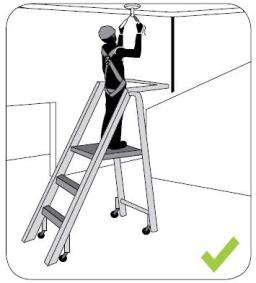.jpg) |
|
20 Jul 2010, Ref: 1011040
Ladder Safety
Many fall-from-height incidents involve the use of ladders. To
prevent injuries arising from such incidents, this article aims to
provide some guidance on the correct and appropriate use of
ladders.
When to use a ladder?
As a first step, consider if working at height is necessary. If
so, decide whether a ladder is the most appropriate access
equipment compared to other options.
In general, ladders should only be used as a means of access to or
egress from a work area, or for light work of short duration. If a
task involves extended periods of working at height or with
restricted movement and vision (e.g. welding), a step platform is
a safer alternative as it is more stable and provides a much
larger work surface than a step ladder.
Is the ladder safe to use?
Before using a ladder, check that it is safe to use. This would
include ensuring that the ladder:
.jpg) Figure 1: If it is necessary to work on a step ladder, work a few steps below the top rung, so that a handhold can be maintained.
Figure 2: A step platform can provide a more stable work surface.
How to use the ladder safely?
The following provides some recommendations on the safe use of
ladders:
.jpg) Figure 3: A ladder with both stiles secured on top Figure 4: Footing the ladder
References
|
